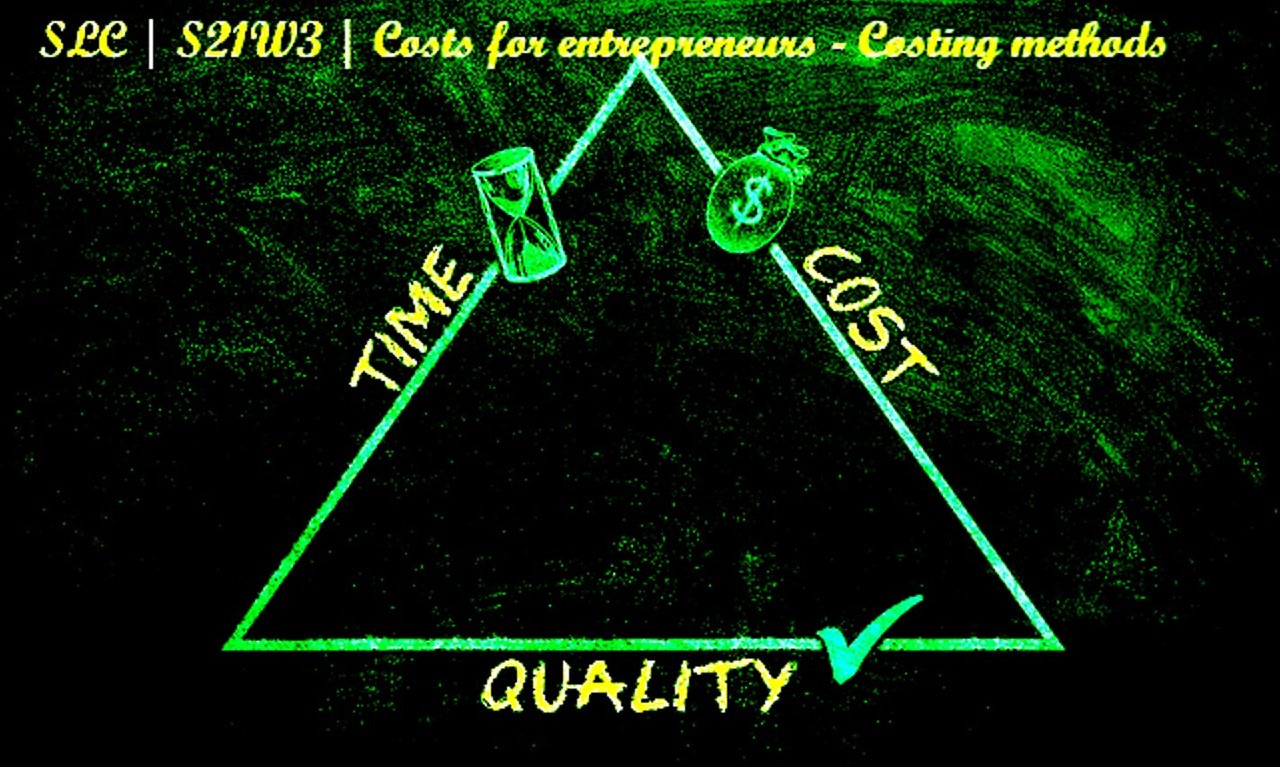SLC | S21W3 | Costs for entrepreneurs - Costing methods
3 comments
Undoubtedly, we use different costing methods, according to the size and type of our business so we can keep an eye on records and costing for various purposes including cost control as well as statuary requirements. I am here to answer SLC | S21W3 | Costos para emprendedores - Métodos de Costeo by @yolvijrm.

What are the costing methods and what is their importance?
Let's first look at the difference between Job Order and Costing by Process Method
Job costing and contract costing are two different accounting methods used to track and manage costs in project-oriented businesses. They are specifically part of cost accounting, each designed for different types of projects.
Job costing is ideal for short-term, small-scale projects and is often applied in manufacturing or service industries where individual jobs or batches vary.
On the other hand, contract costing is designed for larger, long-term projects, most commonly seen in the construction and civil engineering fields, where a single contract lasts a fairly long period.
Explain the difference between the costing method by work orders and by process
For example, manufacturers use their cost of manufacturing based on different batches, keeping into account the cost of materials, labor, and overheads. I will give you an example of a building company using work orders or contract costing building an apartment complex, considering months or years of expenses. This includes materials, labor, wider overheads, and any sub-contracted work.
Job Costing vs Contract Costing
a. Criteria
b. Job Costing
c. Contract Costing
d. Scope Used for small-scale, short-term projects
It is used for large-scale, long-term projects, often lasting several years common in manufacturing, services, and small-scale construction. This method is mainly used in construction and civil engineering. For instance, I was involved in steel girder bridge-making in the mountains where we used this procedure.
Duration
The duration of a project is an important factor. For instance, short-term projects are often completed within the same financial year.
Long-term projects often extend beyond one financial year and this is a different process of cost management.
We take into account
Cost Apportionment
Costs are tracked for each job or batch.
Costs are tracked for the entire contract.
Cost is computed after completion of each job or batch but we must recognize it progressively, corresponding to the percentage of work completed.
Cost Elements Depend upon:
Direct labor, direct materials, and overhead are the major cost elements.
In addition to direct labor and materials, comprehensive overhead, subcontractor, and site costs are also included.
Billing
Billing is usually done on completion of work.
Billing may be periodic, based on contract terms or project accomplishments.
Cost Fluctuations
Cost fluctuations are less likely to occur due to shorter periods.
Cost fluctuations are due to longer periods and more sensitivity to environmental factors.
Profit Recognition
Profit is recognized on completion of each job.
Profit is recognized on a job-completion basis, thereby estimating work-in-progress.

Investigate and explain according to your understanding two methods of costs, different from those explained in this class.
I hereby perform the cost for work orders, as explained for a cake-making venture,
Let's look into the costs of a cake-making venture:
First of all, as a baker, we keep in mind and consider when pricing a cake based on its:-
Size
Ingredients
Skill level
Lead time
Fees for additional services
As a baker, chances are we are in this industry for our love for cakes and the joy they bring to others. The extra joy a beautiful cake can bring to a couple on their wedding day or a child on his birthday makes our job even easier.
What to consider when pricing a cake all baked goods have different prices, and the amount of time, effort, and ingredients used varies as well.
Size
The first thing we take into consideration when someone asks us to make a cake is how big the cake will be.
As a baker, we should know that cakes can range from one to several tiers, and the size usually depends on the number of people attending the event.
Once we figure out the number of layers, we then determine a base cost for each size. There are a few more things we need to consider before determining the price though. Starting with a standard price for one-tier cakes, two-tier cakes, and so on helps us fix a base price, and that we can afford it no matter how complicated the design or how expensive the flavors.
I will give a quick cake serving size here:
6" tier = 14 slices
8" tier = 26 slices
10" tier = 40 slices
12" tier = 56 slices
14" tier = 78 slices
16" tier = 100 slices
and so on...
(source as per the cake industry's normal standards)
Every baker prices their cakes based on the number of servings and then adds things like the customer's desired topper to that base price.
Ingredients
When we accept a cake order, we already have a menu of different flavors of cake. There are trusted favorite flavors like chocolate, vanilla, marble, and funfest, but what if a customer asks for a less popular flavor? That's even more difficult because that ingredient might be out of season or market.
This will affect our costs. Frostings can also quickly change the cost of a cake. Traditional cream is less expensive, while fondant can be a little more expensive.
We can divide ingredients into two categories:
Base ingredients
The raw materials are flour, sugar, vanilla, and eggs that we use in our cakes. We can buy these in bulk, and their price should be standard for every cake order we make.
For example, if our monthly supply of base ingredients costs $500, and we plan to bake 200 cakes in any given month, the minimum amount we should include for our base ingredients is $2.5 per cake.
Special ingredients
This is where fancy cakes come in. If we are making a three-tiered cake, with fresh berries between each layer, add the cost of the fresh fruit to this cake. Let's make sure to account for how many specialty ingredients are needed for each cake.
Once we decide how much the cake will cost based on ingredients and size, it's time to estimate what we need to do to complete the design. When we add modeling chocolate sculptures, meticulous fondant work, or delicate piping and sugar art, the cost of our cake can increase.
It's important to be firm on the price of our work. In addition to the actual cake, we can consider charging for additional services that come with the cake. When your customers order, let them know clearly that certain services will increase the price of the cake.
Overhead Example:
Expert baker
Tasting
Interest
Delivery
Labor
Setup service
The last thing that a baker should not forget is to add his profit so we should add our profit appropriately. After all, the purpose of selling cakes is to make money, isn't it?
So I will keep a fair price for a cake as below but it is important to note that prices can vary considerably depending on where we live and the bakery's level of expertise.
Suppose the average cost per slice average cost per cake is as follows and we have an order for 100 cakes.

Normal Cake Cost of raw material ||$1.50 each ||Overheads 1.10 | Profit 0.60 | Selling Price $3.20
Wedding Cake Cost of raw material ||$2.50 || Overheads 1.20 | Profit 0.80 | Selling Price $4.50
Wedding Cake (S) Cost of Raw material ||$3.50 || Overheads 1.40 | Profit 1.00 | Selling Price $5.90

As I said earlier we use different costing methods, according to the size and type of our business for records, costing, and cost control, however, the formula for batch costing remains the same in any industry depending on :
Batch Costing = (Total cost of goods manufactured/produced / number of units manufactured) x number of units in batch.
I am inviting- @lirvic, @simonmwigwe, and @yonaikerurso
Cc:-
@yolvijrm
Comments